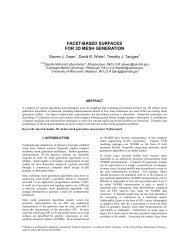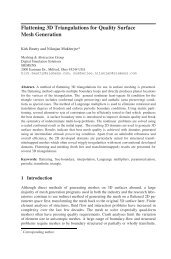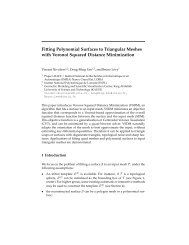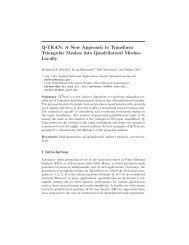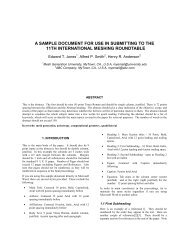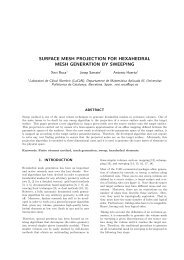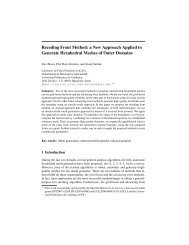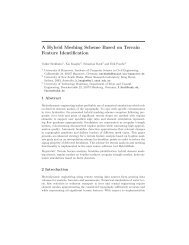Surface Mesh Generation for Dirty Geometries by Shrink ... - Springer
Surface Mesh Generation for Dirty Geometries by Shrink ... - Springer
Surface Mesh Generation for Dirty Geometries by Shrink ... - Springer
You also want an ePaper? Increase the reach of your titles
YUMPU automatically turns print PDFs into web optimized ePapers that Google loves.
<strong>Surface</strong> <strong>Mesh</strong> <strong>Generation</strong> <strong>for</strong> <strong>Dirty</strong> <strong>Geometries</strong><br />
<strong>by</strong> <strong>Shrink</strong> Wrapping using Cartesian Grid Approach<br />
Y. K. Lee 1 , Chin K. Lim 2 , Hamid Ghazialam 3 , Harsh Vardhan 4 and Erling Eklund 5<br />
1<br />
Fluent USA Inc., Evanston, IL 60201 ykl@fluent.com<br />
2<br />
Fluent USA Inc., Austin, TX 78746, ckl@fluent.com<br />
3<br />
Fluent USA Inc., Lebanon, NH 03766, hsg@fluent.com<br />
4<br />
Fluent India Pvt Ltd., Hinjewadi, Pune 411057, India, hxv@fluent.co.in<br />
5<br />
Fluent France S.A., 78180 Montigny le Bretonneux, France, erling@fluent.fr<br />
Summary. A Cartesian shrink wrapping technique has been investigated in this study to<br />
construct triangular surface meshes <strong>for</strong> three-dimensional dirty geometries. The geometries<br />
dealt in this paper are defined <strong>by</strong> faceted representation with dirtiness such as noncon<strong>for</strong>ming<br />
edges, gaps and overlaps. The objective of the proposed technique is to deliver<br />
a way constructing triangular surface meshes <strong>for</strong> upstream solutions in design processes<br />
without extensive labors <strong>for</strong> healing dirtiness in complicated dirty geometries. A Cartesian<br />
grid is overlaid onto the dirty geometries and its cells are adaptively refined until target<br />
resolution is achieved while recording intersections with geometric facets in cells. An initial<br />
watertight shell called the wrapper surface is constructed <strong>by</strong> selectively extracting the<br />
boundary sides of intersected cells. The wrapper surface is improved <strong>by</strong> a subsequence of<br />
operations such as projecting nodes onto geometry, adjusting nodes on the geometry and<br />
editing local triangular faces to achieve better approximation. The meshes generated using<br />
the presented technique may not be geometrically accurate but their quality is good enough<br />
to quickly deliver upstream fluid analysis solutions with significantly reduced engineering<br />
time <strong>for</strong> problems of extreme complexity such as the full underhood fluid/thermal analysis<br />
<strong>for</strong> automobiles. <strong>Mesh</strong> generation experiments have been carried out <strong>for</strong> complicated geometries<br />
and results from some applications are presented in this paper.<br />
1. Introduction<br />
Automatic mesh generation has become an essential tool <strong>for</strong> the finite element<br />
or finite volume analyses of practical engineering problems. The geometries<br />
of the problems are defined as CAD data and access to in<strong>for</strong>mation<br />
stored in CAD data can be provided either through geometric
394 Y.K. Lee et al.<br />
modeling kernel or exporting the data in a <strong>for</strong>mat loadable into the target<br />
system [BWS03]. The IGES and STEP are most commonly used protocols<br />
<strong>for</strong> exchanging CAD data from one CAD system to the other system. Even<br />
though the STEP normally delivers better translation results than IGES<br />
does <strong>by</strong> providing in<strong>for</strong>mation with representations and global tolerances,<br />
immigration of CAD data from one system to the other often results in<br />
dirty geometries containing gaps, holes, overlaps and non-con<strong>for</strong>mal edges<br />
which do not exist in the native data. The inconsistency of tolerant modeling<br />
methods in two systems is one of major reasons causing dirtiness in the<br />
imported geometry. Another source of dirty geometries often ignored is the<br />
urgent need of upstream solutions in practice. In such cases, engineers<br />
have to carry out simulation even be<strong>for</strong>e all the parts in the model have not<br />
been designed <strong>by</strong> leaving small voids or using similar parts in their legacy<br />
library.<br />
Imbedding the mesh generation system in CAD systems can be a way to<br />
avoid the dirtiness from happening, since the meshing operation can be<br />
applied on the native data without translation. The cost <strong>for</strong> imbedding is<br />
extremely expensive and it cannot be done often due to issues other than<br />
technical ones. An alternative <strong>for</strong> imbedding is to develop the mesh generation<br />
system inter-operatable with CAD systems. The development cost<br />
<strong>for</strong> this framework is lower than that of imbedding. However, this approach<br />
needs both the CAD and the mesh generation system to be available<br />
locally. In addition, the CAD data and the mesh data should be managed<br />
separately afterward.<br />
Most conventional approach is to heal the dirtiness <strong>by</strong> directly editing<br />
geometric entities of dirty geometries. Manual healing <strong>for</strong> dirty geometric<br />
models is very labor intensive and time consuming as engineers should destructively<br />
replace the old geometric entities using sophisticated reasoning.<br />
An investigation was carried out <strong>for</strong> detail suppression using topological<br />
modifications and the concept of virtual topology was suggested to define<br />
topologies of problems using underlying dirty geometries without extensive<br />
editing [SBC97]. Yet cleaning up dirty geometries requires considerable<br />
user interactions.<br />
While the previous algorithms intend to fix dirtiness in CAD models,<br />
the scope of this study is focused on generation of meshes without altering<br />
the input geometries. A major bottleneck from dirty geometries to 3D fluid<br />
simulations lies in constructing watertight surface meshes as the subsequent<br />
tetrahedral volume mesh generation is relatively straight<strong>for</strong>ward.<br />
The Cartesian grid approach and shrink wrapping technique are employed<br />
to tackle the problem in the present study. The shrink wrapping approach<br />
was proposed <strong>by</strong> Kobbelt et al. [KVL99] In their approach, a plastic membrane<br />
is wrapped around an object and shrunk either <strong>by</strong> heating the material<br />
or <strong>by</strong> evacuating the air from the space in between the membrane and
<strong>Surface</strong> <strong>Mesh</strong> <strong>Generation</strong> <strong>for</strong> <strong>Dirty</strong> <strong>Geometries</strong> 395<br />
the object’s surface. Theoretically, the plastic skin provides an exact imprint<br />
of the given geometry at the end of process. The problems in applying<br />
their technique to dirty geometry meshing are, first, the construction of<br />
wrapping membrane surface is difficult and, second, the projection operator<br />
may not always provide reliable results to compute traction and relaxation<br />
due to the nature of dirtiness. Thus, the Cartesian grid approach is introduced<br />
to construct the wrapping (or wrapper) surface and geometric<br />
modification on the surface is taken to improve closeness of the wrapper<br />
surface to the given geometry.<br />
The Cartesian grid generation is a well-established technique. Basically,<br />
it overlays an axis-aligned structured grid onto the geometry of a problem<br />
and takes a part of the grid, which is in the region of interest. Later, the<br />
nodes near the input geometry can be repositioned or local structure of<br />
mesh can be modified. The octree technique <strong>for</strong> constructing tetrahedral<br />
meshes can be classified into this technique as it checks intersections between<br />
the cells in the tree and the input geometry and refines each cell in<br />
the region of interest based on intersecting pattern [She85]. Schneider is an<br />
early investigator with full hexahedral elements <strong>for</strong> 3D volume mesh generation<br />
[Sch95]. Aftosmis and his colleague presented a technique clipping<br />
geometric facets with Cartesian cells and using such in<strong>for</strong>mation in fluid<br />
simulations [ABM97] and an extended technology has been used in extracting<br />
large scale models such as building geometries using shape profiles<br />
[WCG05]. Wang extended the application of this technique to dirty<br />
geometry cases [ZF02]. He pointed out that the Cartesian mesh generation<br />
is tolerable to dirtiness of geometries as long as the region of interest can<br />
be classified. And the zigzag boundary of the meshes can be improved using<br />
the best approximation available. There have been active development<br />
works to exploit such technology in extremely complicated applications<br />
with many components and some dirtiness in industrial field [CDA06,<br />
CEI06, CFD06] but few articles have been published in the open literature.<br />
More recently, Boschoff and Pavic carried out an extensive research <strong>for</strong><br />
extracting clean surface meshes from architectural models containing<br />
penetrating and touching components [BP05].<br />
2. Outline of the Proposed Algorithm<br />
The major difficulty in generating 3D volume meshes <strong>for</strong> dirty geometries<br />
<strong>for</strong> fluid simulations with traditional mesh generation tools is to make the<br />
dirty geometry clean so that the meshing tools can be applied step <strong>by</strong> step,<br />
<strong>for</strong> instance, from edge meshing to surface meshing and, then, to volume<br />
meshing. The main idea of the technique presented is (1) to construct a
396<br />
Y.K. Lee et al.<br />
watertight surface mesh <strong>for</strong> a dirty geometry <strong>by</strong> extracting a closed surface<br />
representation from underlying Cartesian grid and (2) improve the surface<br />
mesh while maintaining water-tightness <strong>for</strong> better approximation to the<br />
original geometry. The watertight faceted representation (or surface mesh)<br />
may not precisely represent geometric details of the model but, at least,<br />
provides a quality surface mesh <strong>for</strong> the subsequent tetrahedral volume<br />
mesh generation and, eventually, the upstream fluid simulation. The two<br />
phases can be concisely summarized as follows.<br />
Overlaying Cartesian grid and extracting wrapping surface: A simple<br />
Cartesian grid of small number of cells is overlaid to the input geometry.<br />
The cells in the grid are refined until all of them satisfy criteria. The refinement<br />
<strong>for</strong> Cartesian cells is carried out while checking intersections between<br />
cells and the input geometry. Given the intersecting cells, all the<br />
non-intersected cells are classified into regions bounded <strong>by</strong> the intersecting<br />
cells. By collecting outer front of intersecting cells, it is possible to construct<br />
a watertight surface, so-called the wrapper surface, <strong>for</strong> each region.<br />
Modifications of wrapper surface: In general, the initial wrapper surface<br />
represents the topology of a volume collectively defined <strong>by</strong> the input surfaces.<br />
However, the detailed geometry of the wrapper surface is far different<br />
from that of the input volume. The wrapper surface is modified <strong>by</strong> adjusting<br />
nodal positions or editing local connectivity of nodes to get better<br />
geometric approximation to the input geometry.<br />
overlap<br />
gap<br />
Input geometry<br />
with dirtiness<br />
(hole, overlaps<br />
intersections, etc.)<br />
Overlaying<br />
Cartesian grid<br />
and intersection<br />
computations<br />
Extracting watertight<br />
shell(s) of<br />
intersecting cells<br />
Projecting<br />
shell onto<br />
geometry<br />
Improving<br />
quality of<br />
geometric<br />
approximation<br />
Fig. 1. Schematic description of wrapping procedure<br />
As briefly demonstrated in Figure 1, it is always possible to construct a<br />
watertight surface approximating the volume boundary <strong>by</strong> extracting the<br />
connected boundary faces of the intersected cells. The typical case in<br />
which the previous statement is not true is when a cell completely falls between<br />
gaps, so-called invisible gap [WS02]. However, geometries in practice<br />
are reasonably well defined and the failure would not happen if cells<br />
around gaps are larger than gap distance.
3. Initial Wrapper <strong>Surface</strong> <strong>Generation</strong><br />
<strong>Surface</strong> <strong>Mesh</strong> <strong>Generation</strong> <strong>for</strong> <strong>Dirty</strong> <strong>Geometries</strong> 397<br />
The first phase of the current technique is to construct a rough approximation<br />
<strong>for</strong> the input dirty geometry, the wrapper surface. This section describes<br />
how to generate the initial wrapper surface using the Cartesian grid<br />
technique.<br />
3.1 Initial Cartesian Grid <strong>Generation</strong><br />
The faceted representation such as the stereolithography (STL) <strong>for</strong>mat is<br />
used to define the input geometry in this study. The STL <strong>for</strong>mat is popular<br />
due to its simplicity and portability. The facets in the geometry are stored<br />
in a search tree to be used <strong>for</strong> the intersection checks and projection in this<br />
study.<br />
A uni<strong>for</strong>m Cartesian grid is overlaid on the input geometry and its cells<br />
are adaptively refined later. The Cartesian grid is defined with cells and<br />
faces. In this paper, cells are defined with their six faces, locations and dimensions.<br />
Each face records its left and right neighbor cells. They also<br />
store references to child faces in case of refinement. Vertices are not used<br />
because they are not necessary [ABM97].<br />
3.2 Adaptation of the Grid<br />
Starting from the initial grid, an adaptive grid is constructed <strong>by</strong> gradually<br />
refining cells until all cells satisfy give size criteria. The size functions<br />
[ZBS02] are used to define the desired local sizes. While the curvature size<br />
function generally regards quality of geometric approximation, the proximity<br />
size functions may result topological difference of surface meshes<br />
obtained. For example as shown in Figure 2, insufficient refinement between<br />
gaps in a single connected simple geometry results a double connected<br />
representation. The problem is resolved only after two more refinement<br />
<strong>for</strong> cells (see Figure 2(b)). In 2D cases, cells of size 2G / 2 are<br />
required to ensure that the gaps are resolved regardless to orientations and<br />
translations. Similarly, the factor becomes 2G / 3 in 3D cases. The<br />
maximum difference of refinement between neighboring cells is limited to<br />
1 both <strong>for</strong> simplicity in the data structure and smooth transition of cell<br />
sizes.
398<br />
Y.K. Lee et al.<br />
3.3 Extracting Initial Wrapper <strong>Surface</strong><br />
In the adapted Cartesian grid, there may be several groups of contiguous<br />
non-intersecting cells, the regions. A region may represent a virtual volume.<br />
In complicated models, there are multiple virtual volumes and geometric<br />
complexity often results exceptional cases.<br />
Let us paint cells intersecting the input geometry in a simple grid shown<br />
in Figure 3(a). Naturally, those cells <strong>for</strong>m virtual walls which separate<br />
non-intersecting cells into regions. Starting from a side of an intersecting<br />
cell on the exterior region, a closed shell can be extracted <strong>by</strong> following<br />
neighboring boundary sides of intersecting cells (see Figure 3(b)). There<br />
might be exceptional cases as shown in the interior regions causing nonmanifold<br />
connection and fictitious regions. The intersection status of some<br />
cells should be manipulated to resolve such cases.<br />
G<br />
D<br />
(a)<br />
(b)<br />
Fig. 2. Proximity size function to resolve gaps<br />
nonmanifoldness<br />
fictitious volume created <strong>by</strong> noise<br />
Fig. 3. Nonmanifoldness and fictitious region
4. Improvement of Wrapper <strong>Surface</strong>s<br />
<strong>Surface</strong> <strong>Mesh</strong> <strong>Generation</strong> <strong>for</strong> <strong>Dirty</strong> <strong>Geometries</strong> 399<br />
In general, the initial wrapper surface extracted from the Cartesian grid<br />
topologically represents the virtual volume that is desired to recover. However,<br />
its geometric details, the zigzag configurations, are far different from<br />
the desired geometry. The remaining procedure of the developed technique<br />
is to improve such poor geometric approximation that it represents the input<br />
geometry better. This is done <strong>by</strong> adjusting node positions and locally<br />
editing triangular elements.<br />
4.1 Projection of Nodes<br />
The first step <strong>for</strong> improving the wrapping surface is to move nodes of the<br />
zigzagged wrapper surface onto the input geometry. The simplest way is to<br />
project the nodes onto the nearest points on the input geometry. However,<br />
the nearest point projection may not give desired results as schematically<br />
shown in Figure 4.<br />
Fig. 4. Abnormal projection of node<br />
Due to the nature of the current approach, it is obvious that all the nodes<br />
are all inside of the volume. (Or all nodes should be outside of the volume<br />
if the exterior wrapper surface was taken.) Thus all nodes should be projected<br />
to either outward or inward. An approximated normal vector,<br />
a node, N, is computed as<br />
N<br />
n ~<br />
v<br />
, at<br />
n<br />
N<br />
v<br />
<br />
<br />
i<br />
<br />
i<br />
n<br />
n<br />
F<br />
i<br />
F<br />
i<br />
,<br />
n<br />
~<br />
N<br />
v<br />
<br />
n<br />
n<br />
N<br />
v<br />
N<br />
v<br />
<br />
<br />
<br />
j<br />
<br />
j<br />
n<br />
n<br />
N<br />
j<br />
N<br />
j<br />
(1)<br />
where<br />
F<br />
n is a normal vector of its adjacent face and N i<br />
n is the averaged<br />
v<br />
normal vector of them. When a node is found to have the sign of inner<br />
product of its approximated normal vector and projection vector that is inconsistent<br />
to those of its neighboring nodes, some preconditioning such as
400<br />
Y.K. Lee et al.<br />
a weighted Laplacian smoothing should be done to prevent invalid projection.<br />
In many practical cases, there are distinctive features on the boundary<br />
such as sharp edges and boundary between two zones. Often, it is highly<br />
desired to restore such features in the wrapper surface. In addition to the<br />
projection onto the surface, nodes in the vicinity of feature curves in the<br />
geometry are projected onto the feature curves. For a given feature curve,<br />
the closest nodes from the two ends are found on the wrapper surface and a<br />
path between the nodes is traced <strong>by</strong> using the feature curve as a guide. This<br />
procedure is basically traveling through mesh edges from one end node to<br />
the other while comparing distance to the feature curve and dot product of<br />
the edge vectors and the feature curve tangential vector. The tracing may<br />
fail to identify a reliable path and further investigation is undergoing. Even<br />
after identifying a reliable path, it is often observed that the compulsive<br />
projection of the nodes onto the feature curves deteriorates the configurations<br />
of neighboring faces. The projection of nodes is carried out in an incremental<br />
manner while checking validity of neighboring faces.<br />
4.2 Editing Local Connectivities<br />
In general, a finer initial wrapper surface provides better approximation<br />
<strong>for</strong> the input geometry after the projection. However, there may be very<br />
slender and skewed triangles. A set of standard local modification operations<br />
<strong>for</strong> triangles is used to improve such undesirable configurations further.<br />
Edge collapsing: An edge that is unacceptably shorter than its neighboring<br />
edges is removed <strong>by</strong> merging its two end nodes as shown in Figure 5 (a).<br />
Also, this operation is used to coarsen surface meshes [GH97].<br />
Edge splitting: If an edge is too long comparing to its neighboring<br />
edges, then a new node is introduced at its center and its two adjacent faces<br />
are divided into four triangles in Figure 5(b). The edge splitting is also<br />
used to improve skewed triangles.<br />
Edge swapping: The edge swapping shown in Figure 5(c) can be very<br />
effective to improve the closeness of the faces to the geometry as well as<br />
to improve skewness of slender triangles.
<strong>Surface</strong> <strong>Mesh</strong> <strong>Generation</strong> <strong>for</strong> <strong>Dirty</strong> <strong>Geometries</strong> 401<br />
geometry<br />
F 2<br />
F 2<br />
N I N J<br />
F 1<br />
F 1<br />
(a) Edge collapsing<br />
(b) Edge splitting<br />
Fig. 5. Local mesh editing<br />
(c) Edge swapping<br />
4.3 Node Smoothing<br />
Mostly, a weighted Laplacian smoothing [Her76] is used to improve<br />
skewed triangles <strong>by</strong> repositioning nodes. The nodes are projected back to<br />
the input geometry afterward. When a large number of iterations were applied<br />
to improve triangular quality, excessive smoothing deteriorates details<br />
of configurations and makes projection of nodes back to the geometry<br />
harder <strong>by</strong> moving nodes too far from the geometry. In such cases, enhanced<br />
smoothing techniques preserving features and volumes can be very<br />
effective [Tau95, VMM99, ZF02].<br />
4.4 Zone Partitioning<br />
The wrapped surface can be separated into several regions based on the<br />
underlying surfaces. The closest input surfaces are checked <strong>for</strong> every faces<br />
and faces of same corresponding input surface are grouped and separated<br />
into a zone. This is particularly useful when boundary conditions should be<br />
applied <strong>for</strong> certain zones in the fluid simulations later. In many cases, there<br />
are many small fictitious zones after initial separation due to the fact that<br />
the wrapper zone boundaries do not exactly follow those of input surfaces.<br />
In such cases, the faces in small islands are redistributed to neighboring<br />
larger zones.<br />
5. <strong>Mesh</strong> <strong>Generation</strong> Examples<br />
The presented algorithms are implemented in TGrid, a preprocessor <strong>for</strong><br />
FLUENT solver. The developed mesh generator has been exercised on a<br />
set of example problems and the results are presented in the following sections.<br />
The presented examples include a simple geometry to graphically<br />
demonstrate the meshing procedure as well as fairly complicated geometries<br />
having intersecting facets to validate effectiveness of the proposed<br />
technique.
402<br />
Y.K. Lee et al.<br />
5.1 Transport Aircraft: General Wrapping Procedure<br />
A relatively simple example is taken in this section to demonstrate the<br />
typical mesh generation procedure developed.<br />
The model is an artificial transportation aircraft which is composed of<br />
five separate parts – fuselage, two wings and two sheet metal parts joining<br />
the fuselage and wings. An initial Cartesian grid is overlaid to the input<br />
geometry shown in Figure 6(a) and the configurations of intersected cells<br />
can be shown as in Figure 6(b). The connected exterior faces of the cells<br />
were extracted and the faces were triangulated based on predefined pattern<br />
in terms of hanging node configurations. Figure 6(c) shows the initial<br />
shrink wrapped surface after projection. The configuration in Figure 6(c)<br />
was improved using the smoothing, local mesh editing, etc. The final mesh<br />
is presented in Figure 6(d) after the zone partitioning.<br />
Fig. 6. Typical mesh generation procedure. (a) Input geometry; (b) Intersected Cartesian<br />
cells; (c) Initial wrapper surface; (d) Final wrapper surface after improvements
<strong>Surface</strong> <strong>Mesh</strong> <strong>Generation</strong> <strong>for</strong> <strong>Dirty</strong> <strong>Geometries</strong> 403<br />
The following figure shows the minor dirtiness of the model. The part<br />
joining the wing and the fuselage does not share identical nodes and edges<br />
with either parts and some portion is penetrating into the fuselage.<br />
Fig. 7. Dirtiness in aircraft model<br />
Fig. 8. Cartesian grid lines on cutting plane<br />
Figure 8(a) displays the gridlines of the underlying Cartesian grid on a<br />
cutting plane. The white lines are on cells intersecting the input geometric<br />
facets. The regions of different shades in Figure 8(b) represent that they<br />
are in separated regions bounded <strong>by</strong> the intersected cells shown as the<br />
white region.
404<br />
Y.K. Lee et al.<br />
In the existence of distinctive edges, so-called feature lines, in the initial<br />
geometry, such features can be restored in the final mesh <strong>by</strong> projecting<br />
nodes onto the feature lines as shown in Figure 9.<br />
Fig. 9. Feature line recovery<br />
5.2 Combined Engine Block<br />
The second example in this paper is a V8 engine (see Figure 8(a)). The<br />
model contains three types of typical dirtiness to be dealt in dirty geometry<br />
meshing, intersections <strong>by</strong> penetrating parts, holes due to missing parts and<br />
unreliable facets due to poor triangulation common in STL files. Figure<br />
8(b) highlights such dirtiness in circles.<br />
(a) Combined engine block.<br />
Fig. 10. V8 engine<br />
(b) Three types of dirtiness<br />
In general, any holes whose sizes are larger than cells in the Cartesian<br />
grid may result leakages in wrapping procedure. Thus such holes are desired<br />
to be filled prior to the wrapping operation. However, it is almost impossible<br />
to identify such holes in many complicated models in practice. If<br />
a model is wrapped with leakages due to such holes, the resulting wrapped<br />
surface is folded at a certain location, where the leakage occurs and the<br />
wrapper surface propagates into the inside of the volume. In such case, a
<strong>Surface</strong> <strong>Mesh</strong> <strong>Generation</strong> <strong>for</strong> <strong>Dirty</strong> <strong>Geometries</strong> 405<br />
pair of faces can be chosen and the path between them can be tracked as<br />
shown in Figure 11 and the location of the hole should lie on the path. The<br />
hole should be resolved <strong>by</strong> adding additional facets manually.<br />
Figure 12 shows a contour plot displaying the distance of each face center<br />
to the underlying input geometry. This plot can be exploited to quickly<br />
identify locations where higher resolutions with smaller cells are required<br />
if necessary.<br />
Fig. 11. Hole identification with path<br />
tracking<br />
Fig. 12. Distribution of distance between face<br />
centers and underlying geometry<br />
Figure 13(a) illustrates noisy zigzag configurations along the zone<br />
boundaries after partitioning mentioned in the section 4.6. The difficult<br />
cases are to recovery smooth boundary when there is no explicit boundary<br />
between the two zones in the underlying geometry, <strong>for</strong> instance, a pair of<br />
parts penetrating each other. In such cases, the nodes on the zigzag boundary<br />
can be projected onto both parts alternatively and the boundary <strong>for</strong>ms a<br />
smooth line as shown in Figure 13(b).<br />
Fig. 13. Zone partitioning and boundary recovery
406<br />
Y.K. Lee et al.<br />
The CPU time complexity <strong>for</strong> Cartesian grid generation and region<br />
separation is shown in Figure 14 with a linear trend line. The experiment<br />
was done using a Linux machine with 2 Pentium 4 (3.4GHz) processors.<br />
The CPU times spent <strong>for</strong> subsequent modifications such as smoothing,<br />
swapping and coarsening were excluded as they are interactive operations<br />
which are triggered one after the other. From the latest refinement stage of<br />
8,882k cells, 4.12 million triangles were extracted into the initial wrapper<br />
surface and it took 298 seconds to extract those triangles, incrementally<br />
project onto the input geometry and improve severely skewed triangles <strong>by</strong><br />
edge collapsing and swapping.<br />
CPU Times (secs)<br />
120<br />
100<br />
80<br />
60<br />
40<br />
20<br />
Cell Counts<br />
(x1000)<br />
CPU Time<br />
(secs)<br />
Memory<br />
(MB)<br />
76 3 20<br />
374 9 59<br />
1,891 27 252<br />
8,882 101 1,159<br />
0<br />
0 2,000 4,000 6,000 8,000 10,000<br />
Number of Cells (x1000)<br />
Fig. 14. CPU time complexity <strong>for</strong> Cartesian grid generation and region generation<br />
5.3 <strong>Mesh</strong>ing For Underhood and External Aero-Simulation<br />
The example in this section is taken to illustrate an application of the<br />
developed mesh generator <strong>for</strong> a model of industrial complexity and to discuss<br />
the turnaround time in industrial applications. The model <strong>for</strong> a whole<br />
truck body is presented in Figure 15(a) and it contains more than 1250 assembly<br />
parts including ones in underhood shown in Figure 15(b). The<br />
original geometry contains 473156 facets with 237761 vertices.<br />
Several resolution levels have been tested and numerical experiment<br />
carried out using a AMD 64bit Opteron machine shows that the developed<br />
mesh generator takes 3.5 GB <strong>for</strong> 10 million cells and spends 1 hour to generate<br />
60 million cells with intersection checks. The truck body was placed<br />
in an artificial wind tunnel and wrapped with it. The final wrapper surface<br />
consists of roughly 2 million faces and 1 million nodes after coarsening. It
<strong>Surface</strong> <strong>Mesh</strong> <strong>Generation</strong> <strong>for</strong> <strong>Dirty</strong> <strong>Geometries</strong> 407<br />
Fig. 15. Truck model <strong>for</strong> underhood thermal management simulation<br />
took roughly 1 man week to construct the wrapped surface mesh ready <strong>for</strong><br />
tetrahedral volumetric mesh generation from the initial STL files including<br />
hole filling and tailored mesh generation and connection <strong>for</strong> critical parts<br />
such as the heat exchanger.<br />
The volume mesh generation was carried out mainly with tetrahedral<br />
elements and wedge prism layers were applied to some parts. Several failures<br />
occurred due to poor triangular quality and excessively close proximity<br />
between opposing faces. The final volume mesh used <strong>for</strong> the fluid<br />
simulation contains 6.8 million cells with 0.7 million interior nodes with<br />
the boundary entities mentioned prior. Figure 17 shows streamlines and<br />
pressure distributions obtained <strong>by</strong> the simulation.
408 Y.K. Lee et al.<br />
Fig. 16. Configurations of final wrapper surface <strong>for</strong> 3D volume mesh generation<br />
Fig. 17. Streamlines and pressure distributions from CFD simulations
6. Discussions and Future Works<br />
<strong>Surface</strong> <strong>Mesh</strong> <strong>Generation</strong> <strong>for</strong> <strong>Dirty</strong> <strong>Geometries</strong> 409<br />
A mesh generation technique has been investigated to construct triangular<br />
3D surface meshes <strong>for</strong> dirty geometries and applications of the developed<br />
mesh generator have been presented to demonstrate effectiveness of the<br />
proposed technique. The proposed algorithm constructs initial watertight<br />
triangular meshes called the wrapper surfaces from the Cartesian grid<br />
overlaid onto the input dirty geometries <strong>by</strong> analyzing intersections of its<br />
cells. The final wrapper surface is obtained <strong>by</strong> gradually improving until a<br />
quality surface mesh is achieved to proceed to the subsequent tetrahedral<br />
volumetric mesh generation with. As the intersection check in Cartesian<br />
grid generation is tolerant to geometric dirtiness to a certain extent, it is<br />
possible to reduce a significant amount of user interactions that were necessary<br />
in traditional geometric healing.<br />
Further works are under investigation in some areas. For example, it<br />
will be necessary to improve memory efficiency to exploit the presented<br />
technique on extreme applications such as combined fluid simulations of<br />
external aero, underhood thermal management and cabin HVAC. The cells<br />
in the presented study are represented a face-based unstructured data structure.<br />
A comparative study is undergoing using the octree data structure.<br />
Also, several key improvements should be made to deliver special need to<br />
construct meshes <strong>for</strong> volumes with thin surfaces attached to. Automated<br />
hole fixing is another challenging issue. The two major problems are, first,<br />
to identify a hole and, second, resolve it. According to our experience, the<br />
hole can be an artifact one caused <strong>by</strong> missing faces as well as structural<br />
one, <strong>for</strong> example, a hole on a sheet metal component. The <strong>for</strong>mer is relatively<br />
easier to detect due to the existence of free mesh edges each having<br />
only one connected face. The later often appears clean as the thin sheet<br />
metal is defined very close two surfaces that are fully connected to<br />
neighboring surfaces. In the existence of holes, the traditional way is to<br />
patch them with extra triangles manually. An interesting alternative is to<br />
coarsen the cells around a hole so that the hole does not appear in the<br />
wrapper surface. Further study will be carried out <strong>for</strong> this issue.<br />
References<br />
[ABM97]<br />
[BPK05]<br />
[BWS03]<br />
M. J. Aftosmis, M. J. Berger and J. E. Melton (1997) Robust and efficient Cartesian<br />
mesh generation <strong>for</strong> component-based geometry, AIAA Paper 97-0196<br />
S. Bischoff, D. Pavic and L. Kobbelt (2005) Automatic restoration of polygonal<br />
models, ACM Trans. Graphics, 24(4), pp. 1332-1352.<br />
M. W. Beall, J. Walsh and Mark S. Shephard (2003) Accessing CAD geometry<br />
<strong>for</strong> mesh generation. Proc. 12th International <strong>Mesh</strong>ing Roundtable, pp. 33-42
410<br />
Y.K. Lee et al.<br />
[CDA06] CD-Adapco (2006) PROSTAR Automatic <strong>Mesh</strong>ing, http://www.adapco.com/<br />
SoftwareProducts/ proam-htm.htm<br />
[CEI06] CEI Ensight (2006) Harpoon: The Extreme <strong>Mesh</strong>er, http://www.ensight.com/<br />
products/harpoon.html<br />
[CFD06] CFDRC, CFD-VisCART, http://www.cfdrc.com/serv_prod/cfd_multiphysics/<br />
software/ace/viscart.html<br />
[GH97] M. Garland and P. S. Heckbert (1997) <strong>Surface</strong> simplification using quadric error<br />
metrics, Proc. 24 th<br />
Annual Conf. on Computer Graphics and Interactive<br />
Techniques, pp. 209-216<br />
[Her76] L. R. Hermann (1976) Laplacian-Isoparametric Grid <strong>Generation</strong> Scheme, J. of<br />
the Engineering Mechanics Division of the American Society of Civil Engineers,<br />
102, pp. 749-756<br />
[KVL99] L. Kobbelt, J. Vorsatz, U. Labsik and H.P. Seidel (1999) A shring wrapping<br />
approach to remeshing polygonal surfaces, Computer Graphics Forum, 18(3),<br />
pp. 119-130<br />
[PER04] M. Peric (2004) Simulation of flows in complex geometries: New meshing and<br />
Solution Methods, Proc. NAFEMS Seminar: "Simulation of Complex Flows<br />
(CFD) - Application and Trends", Niedernhausen/Wiesbaden, Germany<br />
[She85] M. S. Shephard (1985) Automatic and adaptive mesh generation, IEEE Trans.<br />
Magnetics, 21, pp. 2482-2489<br />
[SBC97] A. Sheffer, T. Blacker, J. Clements and M. Bercovier (1997) Virtual Topology<br />
Operators <strong>for</strong> <strong>Mesh</strong>ing, Proceedings, 6th International <strong>Mesh</strong>ing Roundtable,<br />
pp. 49-66<br />
[Sch95] R. Schneiders (1995) Automatic <strong>Generation</strong> of Hexahedral Finite Element<br />
<strong>Mesh</strong>es, Proceedings, 4th Int. <strong>Mesh</strong>ing Roundtable, pp. 103-114<br />
[SWC00] J. P. Steinbrenner, N. J. Wyman and J. R. Chawner (2000) Fast <strong>Surface</strong> <strong>Mesh</strong>ing<br />
on Imperfect CAD Models, Proc. 9th Int. <strong>Mesh</strong>ing Roundtable, pp. 33-41<br />
[Tau95] G. Taubin (1995) Curve and <strong>Surface</strong> Smoothing without <strong>Shrink</strong>age, Proc. 5th<br />
Int. Conf. Computer Vision, pp. 852-857<br />
[VMM99] J. Vollmer, R. Mencl and H. Müller (1999) Improved Laplacian smoothing of<br />
noisy surface meshes, Computer Graphics Forum, 18(3), pp. 131-138.<br />
[WCG05] A. Wissink, K. Chand, B. Gunney, C. Kapfer, M. Berger, B. Kosovic, S. Chan<br />
and F. Chow (2005) Adaptive urban dispersion integrated model, 8 th American<br />
Meteorological Society Annual Meeting, Atlanta, GA.<br />
[WS02] J. Z. Wang and K. Srinivasan (2002) An adaptive Cartesian grid generation<br />
method <strong>for</strong> '<strong>Dirty</strong>' geometry, Int. J. Numer. Meth. Fluids, 39, pp. 703-717<br />
[ZBS02] J. Zhu, T. Blacker and R. Smith (2002) Background Overlay Grid Size Functions,<br />
Proc. 11th Int. <strong>Mesh</strong>ing Roundtable, pp. 65-74<br />
[ZF02] H. Zhang, E. Fiume (2002) <strong>Mesh</strong> smoothing with shape or feature preservation,<br />
Proc. Computer Graphics International 2002, pp. 167-182.




